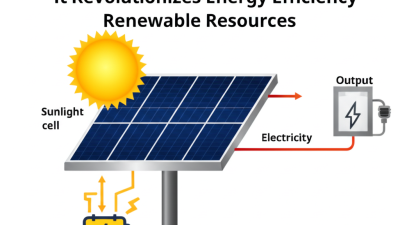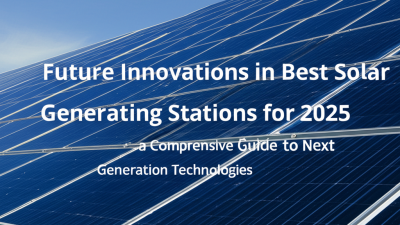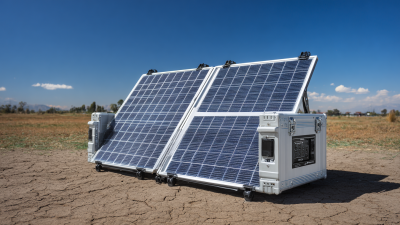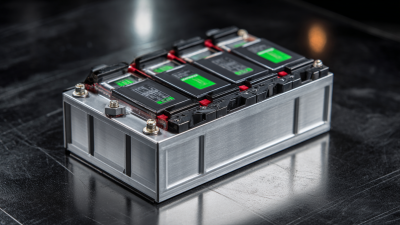What is a Solar Cell Generator and How It Revolutionizes Energy Efficiency in Renewable Resources
Table of Contents
- Understanding the Basics of Solar Cell Generators in Renewable Energy
- Key Components and Technologies Behind Solar Cell Generators
- Benefits of Using Solar Cell Generators for Energy Efficiency
- How Solar Cell Generators Compare to Traditional Energy Sources
- Maintenance Tips for Optimizing Your Solar Cell Generator's Performance
- Future Trends: Innovations in Solar Cell Generator Technology
- FAQS
- Related Posts
As the world increasingly shifts towards sustainable energy solutions, the Solar Cell Generator emerges as a groundbreaking innovation in the renewable resource sector. This technology not only harnesses the abundant energy of the sun but also enhances energy efficiency in various applications. With over 27 years of experience in R&D, manufacturing, and solution services for lithium batteries and energy storage systems, Roofer Electronics Technology (Shanwei) Co., Ltd. is at the forefront of this energy revolution. Our expertise in creating cutting-edge battery products positions us to significantly contribute to the integration of Solar Cell Generators in everyday life, whether it's for household energy storage, electric bicycles, or powering appliances. This blog explores the benefits of Solar Cell Generators and how they can transform energy consumption, making it more sustainable and efficient for everyone.

Understanding the Basics of Solar Cell Generators in Renewable Energy
Solar cell generators are gaining prominence as a key player in the renewable energy landscape. At their core, photovoltaic (PV) cells, commonly referred to as solar cells, function as non-mechanical devices that convert sunlight directly into electricity. This innovative technology not only offers a sustainable energy solution but also enhances energy efficiency by harnessing a clean and abundant resource—solar energy. The increasing reliance on solar cell generators signifies a shift towards more sustainable energy practices, especially as global demand for energy continues to rise.
Understanding the basics of solar cell generators is crucial for maximizing their potential in renewable energy strategies. These generators integrate seamlessly with energy storage systems, ensuring that electricity can be supplied even when the sun isn't shining. By storing energy produced during sunny days, these systems can release power during peak demand periods, thus stabilizing the electricity supply. As the industry evolves, ongoing advancements in materials and technology will further improve the efficiency and accessibility of solar cell generators, making them a cornerstone of the transition towards greener energy solutions.
Key Components and Technologies Behind Solar Cell Generators
Solar cell generators are at the forefront of transforming how we harness renewable energy. At the heart of these systems lies the photovoltaic (PV) cell, which converts sunlight directly into electricity through the photovoltaic effect. When sunlight hits the solar cells, it excites electrons, generating a flow of electric current that can be utilized for various power needs. This technology not only supports off-grid setups but also integrates seamlessly with existing electricity grids, providing a sustainable energy source.
Another essential component of solar cell generators is the inverter, which plays a critical role in converting the direct current (DC) produced by solar panels into alternating current (AC) suitable for home and commercial use. Additionally, advancements in battery storage technology have enhanced the effectiveness of solar energy systems, allowing surplus energy to be stored for later use, especially during non-sunny hours. The optimization of these technologies continues to improve overall energy efficiency and reliability, enabling more households and businesses to engage with renewable resources effectively.
Benefits of Using Solar Cell Generators for Energy Efficiency
Solar cell generators have emerged as a groundbreaking solution in the pursuit of energy efficiency, particularly as the demand for renewable resources increases. These devices convert sunlight into electricity, significantly reducing reliance on fossil fuels and contributing to a cleaner environment. With the recent advancements in solar technology, such as hydrogen generation integrated with solar photovoltaic systems, communities can now meet their energy needs while simultaneously producing clean hydrogen fuel, showcasing the versatility and effectiveness of solar energy.
The financial incentives currently available, including the residential clean energy credit, further encourage homeowners to invest in solar cell generators. By recouping up to 30% of the installation costs through tax credits, homeowners find solar energy not only environmentally beneficial but also economically advantageous. Additionally, the integration of modern energy storage systems enhances the efficiency of solar energy use, ensuring a steady power supply even during non-sunny days. This technological synergy maximizes the potential of solar energy and underscores its role in achieving sustainable energy solutions for the future.
How Solar Cell Generators Compare to Traditional Energy Sources
Solar cell generators represent a transformative shift in the way we harness and utilize energy. Unlike traditional energy sources such as fossil fuels and nuclear power, solar cell generators convert sunlight directly into electricity, offering a cleaner, more sustainable energy option. Traditional sources often come with significant environmental consequences, such as greenhouse gas emissions and resource depletion. In contrast, solar energy is virtually limitless and exponentially more sustainable, making solar cell generators a compelling choice for eco-conscious consumers and industries alike.
When we compare solar cell generators to conventional energy sources, the advantages become clear. Solar cell generators reduce reliance on finite resources and provide energy independence. They operate quietly and require minimal maintenance compared to traditional power plants, which can be complex and resource-intensive. Additionally, advancements in solar technology have led to increased efficiency and reduced costs, making solar cell generators not only environmentally friendly but also economically viable. As more individuals and businesses invest in solar technology, the potential for clean energy to dominate future energy landscapes becomes even more promising.
Comparison of Energy Efficiency: Solar Cell Generators vs. Traditional Energy Sources
Maintenance Tips for Optimizing Your Solar Cell Generator's Performance
To ensure your solar cell generator operates at peak efficiency, regular maintenance is crucial. Start by keeping the solar panels clean and free from debris. Dust, leaves, and bird droppings can significantly reduce the amount of sunlight that reaches the panels, leading to decreased energy output. A gentle wash with water and a soft brush or sponge can help maintain their efficiency. Ideally, check and clean your panels at least twice a year, or more often if your installation is near trees or birds.
In addition to cleaning, monitor the inverter and wiring regularly. The inverter helps convert solar energy into usable electricity, so any signs of malfunction can disrupt performance. Look for error codes on the inverter and listen for unusual sounds. Furthermore, inspect the wiring for any fraying or wear that could lead to power losses. If you notice any issues, it’s best to consult a professional to avoid safety hazards and ensure a reliable energy supply. By following these maintenance tips, you can optimize your solar cell generator's performance and prolong its lifespan.
Future Trends: Innovations in Solar Cell Generator Technology
The future of energy generation is being reshaped by innovative advancements in solar cell generator technology. As researchers and engineers push the boundaries of efficiency and sustainability, solar cell generators are becoming more compact, more powerful, and increasingly accessible.
Emerging trends include the development of bifacial solar panels that can capture sunlight from both sides, significantly boosting overall energy yield. This innovation not only maximizes land use but also enhances the viability of solar energy in various environments, from urban rooftops to large-scale solar farms.
In addition to improved efficiency, advancements in materials science are paving the way for the next generation of solar cells. Perovskite solar cells, for instance, promise to deliver exceptional performance at a lower cost than traditional silicon-based cells.
These lightweight and flexible materials can be integrated into a wide range of surfaces, from building facades to active wearables, making solar energy more versatile than ever. As these technologies continue to mature, we can expect to see a significant reduction in the cost of solar energy production, making clean, renewable energy a more feasible option for individuals and communities alike.
FAQS
: Solar cell generators are systems that convert sunlight directly into electricity using photovoltaic (PV) cells, playing a significant role in the renewable energy landscape.
Solar cells work by utilizing the photovoltaic effect, where sunlight excites electrons in the cells, generating a flow of electric current that can be used for power needs.
Energy storage allows solar cell generators to provide electricity even when the sun isn't shining by storing energy produced during sunny days and releasing it during peak demand periods.
The inverter converts the direct current (DC) produced by solar panels into alternating current (AC) that is suitable for home and commercial use.
Solar cell generators can be integrated seamlessly with existing electricity grids, allowing them to provide a sustainable energy source while supporting off-grid setups.
Ongoing advancements in materials and battery storage technology are enhancing the efficiency and effectiveness of solar energy systems, improving overall energy reliability and accessibility.
Related Posts
-

Future Innovations in Best Solar Generating Stations for 2025 a Comprehensive Guide to Next Generation Technologies
-

2025 Solar Powered Generator Trends and Comparisons to Watch for in the Industry
-

Understanding the Industry Standards for Best 12v Lithium Iron Battery Production
-

Leading Global Manufacturer: Explore the Best 3.2v 100ah Lifepo4 Battery Cells Available Today





 business@roofer.cn
business@roofer.cn +86 13502883088
+86 13502883088






